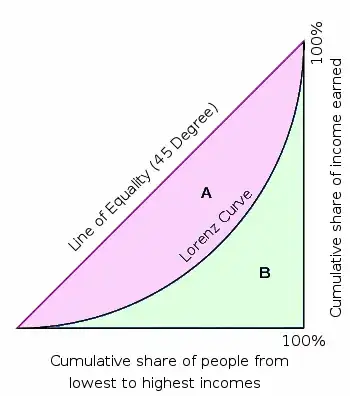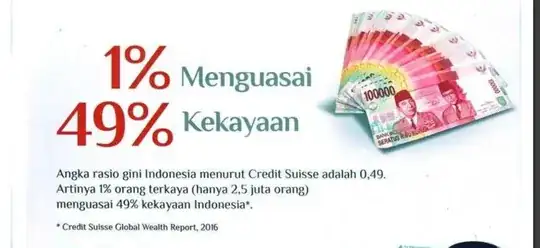Quick answer... this guy is playing demagogue. He's pretending that the gini coefficient means things that it does not.... or perhaps he doesn't necessarily understand (or care) himself.
On the gini coefficient, I've found a blog by a math teacher that appears to lay it out pretty clearly.

[...]
In plain English, the graph above indicates the proportion of the
income going to the poorest people, middle-income people and richest
people.
There will always be rich and poor, but we are interested in how
evenly wealth is distributed and most governments put effort into
keeping this coefficient as low as possible.
The Gini Coefficient ranges between 0 and 1 (or it can also be
expressed as a number from 0 to 100) and is given by the ratio of the
areas:
Gini Coefficient = {A}/{A+B}
If A = 0, it means the Lorenz Curve is actually the Line of Equality.
In this case, the Gini Coefficient is 0 and it means there is
"perfect" distribution of income (everyone earns the same amount).
If A is a very large area (making B very small), then the Gini
Coefficient is large (almost 1) and it means there is very uneven
distribution of income. Countries with a high Gini Coefficient are
more likely to become unstable, since there is a large mass of poor
people who are jealous of the small number of rich people.
It also seems to agree with what wikipedia has to say on the subject.
So... conclusion from that, it's possible to have a gini coefficient of .49 while 49% of the money is held by 1% of the people, but if I'm understanding the math correctly, it would mean that the money in the rest of the populace would be almost perfectly distributed. That's.. unlikely. Gini 0.49 is actually pretty good.
That's not what's going on, though. Credit Suisse databook 2016 (page 107) lists Indonesia as having a wealth gini of 84.0%, which is quite a lot worse than 49%. Based on that, it's possible that 1% of the population does hold 49% of the money, but it certainly doesn't follow directly.
now, the numbers do look fairly dire. It's not like his overall position about wealth distribution is unfounded... it's just that those numbers don't mean what he's saying they mean.

